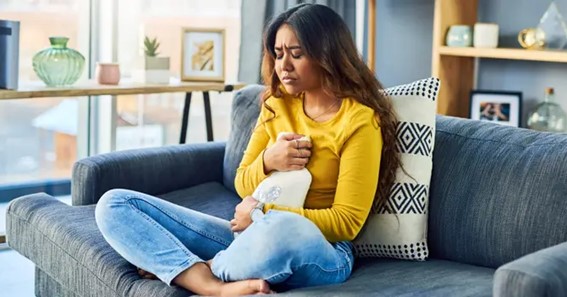Very many women experience painful periods, which can have a considerable negative impact on their everyday lives. These symptoms are connected to the menstrual cycle and frequently indicate the beginning of menstruation or its impending arrival.
Lower abdominal cramps or contractions are what menstrual pain feels like (uterus, ovaries). They may expand into the stomach and legs. Period pain may be a sign of a disease or simply a menstrual cycle symptom. Here’s a simple fix for uncomfortable periods.
What are uncomfortable periods?
The contraction of the uterus is a contributing factor in period pain. The name for these pains is dysmenorrhea. They are typically unimportant and normal. You must use caution, though, as they should not be so severe as to significantly impair daily life.
The pains might spread to other areas of the body (legs, back, etc.) and linger for several days. They may result in severe weariness and headaches. Sometimes the pain is so severe that it tops the list of reasons why young women miss work on the job. The same is true for young girls and teenagers who miss class.
Because they happen during or right before menstruation, cramps are frequently associated with the menstrual cycle. In fact, during these, the uterus must discharge the endometrium in the absence of fertilization. What are the guidelines? Prostaglandins, a chemical that causes the uterus to contract, promote this ejection.
Young females frequently experience more discomfort during their first menstruation than during subsequent ones. Indeed, the uterus contracts excessively in young women because they secrete too many prostaglandins.
Additionally, the cycle is organized and can occasionally be erratic; this is totally normal. As women mature, their cycles should typically have a periodicity of roughly 28 days.
There are numerous treatments for these symptoms, such as Holief’s cramp cream with menthol which is available to ease unpleasant periods. Sometimes, these treatments are associated with complementary medicine (yoga, relaxation, essential oils). Analgesics and other non-steroidal anti-inflammatory medications (nsaids) are alternative options for pain relief.
Click here – What Is R4 Zoning?
How may you fast relieve them?
Massaging one’s own stomach
If you know the appropriate technique, belly self-massage can ease period pain. To find out how, watch the video below.
Put heat on
One of the most well-liked and frequently used methods to relieve uncomfortable periods is to apply heat to the lower abdomen. Menstrual cramps can be relieved and muscles can relax by applying a hot water bottle or warm towel. It is also calming to take a hot bath, which might have the similar result.
Dietary supplements
It is becoming more and more common to take nutritional supplements to ease period pain. These supplements include a variety of vitamins as well as essential oil and plant extracts that can be used to treat cramps and maintain the regularity of the menstrual cycle.
Ingest medicine
Taking medicine is frequently the most efficient strategy to rapidly relieve period discomfort. An analgesic like paracetamol or ibuprofen will typically be prescribed by a doctor.
Aspirin should be avoided, though. Your periods will get heavier as a result, which can be irritating because this encourages bleeding. Another choice is to take an antispasmodic, which eases uterine cramps. In any event, exercise caution to avoid abusing drugs excessively.
Click here – 5 Eco-Friendly Habits That Can Save You Money
Physical exercise
Sometimes engaging in a little physical exercise will help with cramps. A relatively easy sport, like swimming or walking, can help to ease pain and relax the pelvic.
To avoid the opposite impact (pain, heavy bleeding), physical activity shouldn’t be done at an excessive intensity.
Due to the perineum and pelvis being relaxed by pleasure hormones, having intercourse can occasionally have the same consequences. Of course, in order to do something, you must desire to, which is not always simple at this time of the month.
Yoga poses to reduce menstrual pain
Another physical exercise that reduces pain is yoga. You can find useful activities to use for this in the video below. Ideal to support your natural search for equilibrium and wellness.
When do you need to worry?
It’s not typical to experience pain during your period. Although cramps are frequent, you should be concerned if they are so painful that they interfere with your everyday activities. The discomfort shouldn’t be so intense that it makes you dizzy, queasy, or throw up. You should be able to go about your day regularly and move around without being hindered by it.
Period discomfort may be a sign of diseases like polycystic ovarian syndrome or endometriosis (PCOS).
Be alert for more potential symptoms. Consultation is required if the periods are very frequent and erratic in addition to being painful. The ability to recognize potential signs of a hormonal imbalance, such as hypervelocity (hirsutism), infertility, acne, or being overweight, is also essential.
There is no question that observing these symptoms should result in a visit to the doctor, particularly a gynecologist. Making a diagnosis and providing the right therapy will only be able to be done by a medical practitioner that specializes in gynecology.
To sum up, if the pain is unbearable, you must immediately see a doctor or gynecologist and begin a follow-up with him. He or she can recommend the tests and therapies required for your circumstance. Don’t be reluctant to speak with your general practitioner if you have any questions, reservations, or other concerns.

